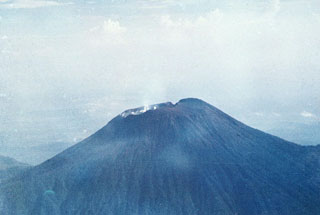Report on Slamet (Indonesia) — July 1988
Scientific Event Alert Network Bulletin, vol. 13, no. 7 (July 1988)
Managing Editor: Lindsay McClelland.
Slamet (Indonesia) Activity decreases to quiet fuming
Please cite this report as:
Global Volcanism Program, 1988. Report on Slamet (Indonesia) (McClelland, L., ed.). Scientific Event Alert Network Bulletin, 13:7. Smithsonian Institution. https://doi.org/10.5479/si.GVP.SEAN198807-263180
Slamet
Indonesia
7.242°S, 109.208°E; summit elev. 3428 m
All times are local (unless otherwise noted)
The eruption that began on 12 July ejected incandescent lava to 100 m above the summit, accompanied by a 200-m fume cloud. Similar activity continued the next day [see also 14:11]. Between 14 and 19 July, heavy fuming produced an 800-m light-colored plume. After 19 July, only quiet fuming persisted. No evacuations were necessary.
Geological Summary. Slamet is one of Java's most active volcanoes. It has a cluster of about three dozen cinder cones on its lower SE-NE flanks and a single cinder cone on the W flank. It is composed of two overlapping edifices, an older basaltic andesite to andesitic volcano on the west and a younger basaltic to basaltic andesite one on the east. Gunung Malang II cinder cone on the upper E flank on the younger edifice fed a lava flow that extends 6 km E. Four craters occur at the summit of Gunung Slamet, with activity migrating to the SW over time. Eruptions recorded since the 18th century have originated from a 150-m-deep, 450-m-wide, steep-walled crater at the western part of the summit and have consisted of explosive eruptions generally lasting a few days to a few weeks.
Information Contacts: VSI.

